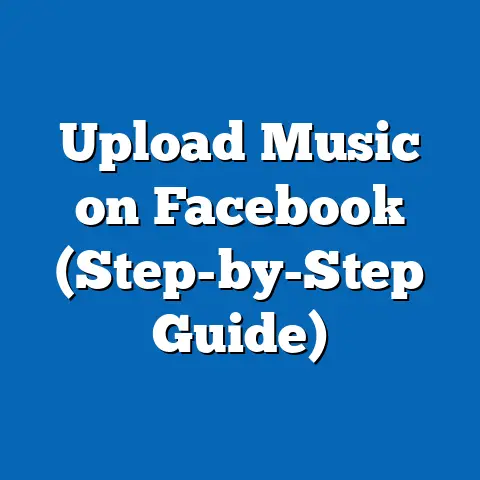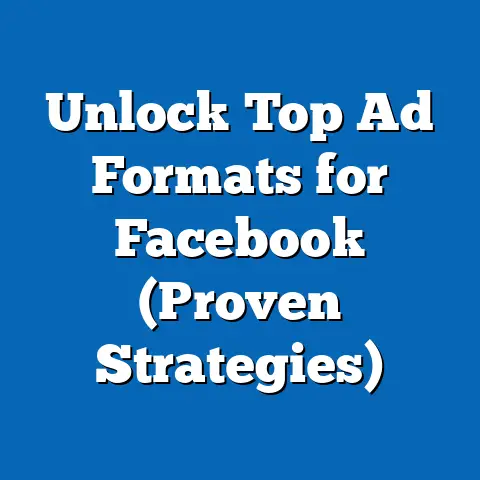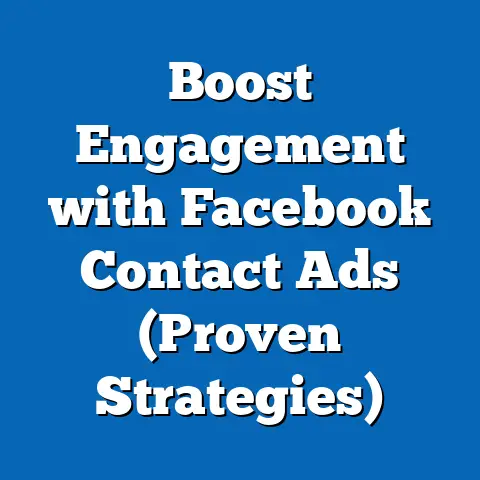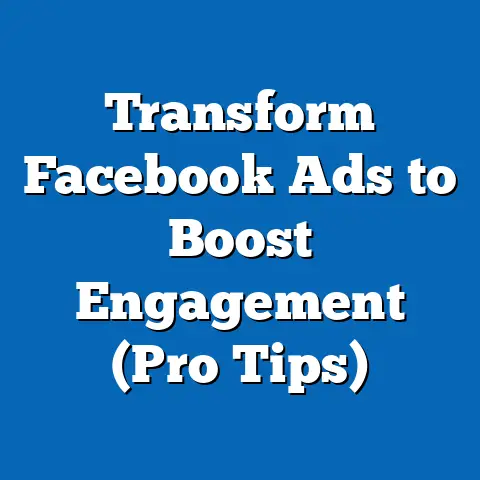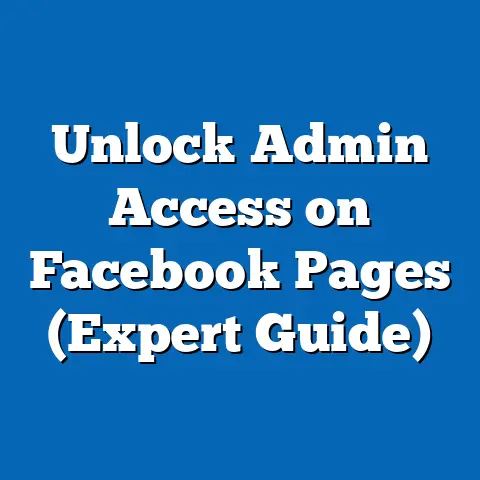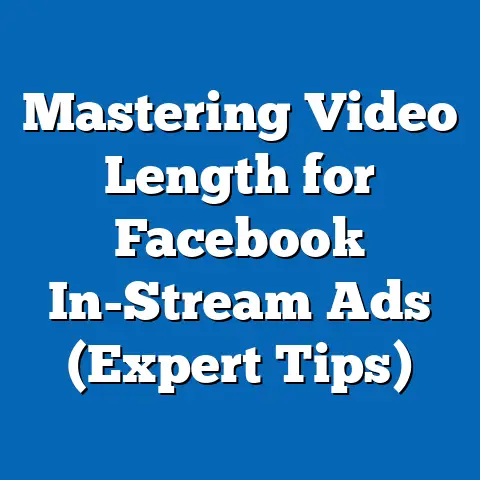Transform Facebook Ads Copy to Boost Engagement (Pro Tips)
Remember those old Coca-Cola commercials with the polar bears, or the “Got Milk?” ads that were everywhere? I do. They weren’t just selling a product; they were telling a story, creating a feeling. That’s the power of good advertising, and it all starts with the words – the copy. In today’s digital world, Facebook ads are our billboards, and the copy is our message. But with so much noise online, how do you cut through the clutter and create ads that not only get seen but also get clicked?
That’s what I’m here to share with you. This isn’t just another list of generic tips. I’m going to dive deep into the art of crafting Facebook ad copy that grabs attention, speaks to your audience, and ultimately drives engagement. I’ll share actionable strategies, real-world examples, and even some of the mistakes I’ve made (so you don’t have to!). Get ready to transform your Facebook ads from bland to brilliant!
Section 1: Understanding Your Audience
Before you even think about writing a single word, you need to know who you’re talking to. Think of it like this: you wouldn’t use the same language with your grandma as you would with your best friend, right? The same principle applies to advertising.
Why Audience Research Matters:
- Relevance is Key: Facebook’s algorithm rewards ads that are relevant to the user. The more relevant your ad, the higher the chance it will be shown and the lower your costs will be.
- Speaks Their Language: Understanding your audience’s demographics (age, location, gender), interests, and even their pain points allows you to craft copy that resonates with them on a personal level.
- Avoids Wasted Spend: Targeting the wrong audience is like throwing money into a black hole. Effective audience research ensures your ads are seen by people who are actually interested in what you have to offer.
Different Audiences, Different Approaches:
Let’s say you’re selling a fitness app. You might target two different segments:
-
Segment 1: Busy Professionals (25-45 years old)
- Copy Style: Focus on convenience, efficiency, and time-saving benefits. Think phrases like “Squeeze in a workout during your lunch break” or “Achieve your fitness goals in just 15 minutes a day.”
- Tone: Professional, results-oriented, and slightly aspirational.
-
Segment 2: College Students (18-24 years old)
-
Copy Style: Highlight affordability, social aspects, and fun challenges. Think phrases like “Workout with your friends and crush your fitness goals” or “Join the ultimate fitness challenge and win prizes!”
- Tone: Energetic, playful, and relatable.
Segment 1: Busy Professionals (25-45 years old)
- Copy Style: Focus on convenience, efficiency, and time-saving benefits. Think phrases like “Squeeze in a workout during your lunch break” or “Achieve your fitness goals in just 15 minutes a day.”
- Tone: Professional, results-oriented, and slightly aspirational.
-
Segment 2: College Students (18-24 years old)
-
Copy Style: Highlight affordability, social aspects, and fun challenges. Think phrases like “Workout with your friends and crush your fitness goals” or “Join the ultimate fitness challenge and win prizes!”
- Tone: Energetic, playful, and relatable.
Segment 2: College Students (18-24 years old)
Copy Style: Highlight affordability, social aspects, and fun challenges. Think phrases like “Workout with your friends and crush your fitness goals” or “Join the ultimate fitness challenge and win prizes!”
Creating Buyer Personas:
A buyer persona is a semi-fictional representation of your ideal customer based on research and data about your existing customers. It’s not just about demographics; it’s about understanding their motivations, goals, and challenges.
Example:
- Name: Sarah, the Busy Professional
- Age: 35
- Occupation: Marketing Manager
- Goals: Stay healthy, manage stress, improve energy levels
- Challenges: Limited time, demanding work schedule, lack of motivation
- Quote: “I want to stay in shape, but I just don’t have the time for long workouts.”
By creating a detailed buyer persona like Sarah, you can tailor your ad copy to directly address her needs and desires. You can use her quote as inspiration for your ad, or highlight how your fitness app solves her specific challenges.
Takeaway: Before writing a single line of copy, invest time in understanding your audience. Create buyer personas, research their interests, and tailor your messaging to resonate with their specific needs and desires. This is the foundation for creating high-engagement Facebook ads.
Section 2: Crafting a Strong Hook
Think of the hook as the bait that lures your audience in. In the crowded landscape of Facebook, you have mere seconds to grab someone’s attention and make them stop scrolling. A weak hook is like offering a fish a stale cracker – it’s just not going to work.
What is a Hook?
The hook is the opening line or visual element of your ad that immediately captures attention and entices the user to learn more. It’s the “wow” factor that makes them think, “Hey, this might be interesting.”
Techniques for Writing Effective Hooks:
- Ask a Question: Questions pique curiosity and encourage engagement. “Tired of feeling tired?” or “Struggling to lose weight?” These questions instantly qualify your audience and draw in those who can relate.
- Use Shocking Statistics: Numbers can be powerful attention-grabbers. “Did you know that 80% of people fail their New Year’s resolutions?” This statistic immediately highlights a problem and positions your product as a solution.
- Make a Bold Statement: A confident and intriguing statement can be highly effective. “The only diet you’ll ever need” or “Finally, a skincare solution that actually works.” Just be sure you can back up your claims!
- Offer a Solution to a Common Problem: Directly address a pain point your audience experiences. “Say goodbye to back pain” or “Unlock your productivity potential.”
Examples of Successful Facebook Ads with Strong Hooks:
-
Ad Example 1: Grammarly:
- Hook: “Great writing, simplified.”
- Why It Works: It’s concise, clear, and promises a direct benefit to anyone who writes online.
-
Ad Example 2: MasterClass:
-
Hook: “Learn from the best.” (Often paired with an image of a celebrity instructor)
- Why It Works: It leverages the authority and expertise of well-known figures to create instant credibility and appeal.
-
Ad Example 3: Monday.com:
-
Hook: “One platform to run your entire work.”
- Why It Works: It speaks directly to the pain point of managing multiple tools and promises a unified solution for project management.
Ad Example 1: Grammarly:
- Hook: “Great writing, simplified.”
- Why It Works: It’s concise, clear, and promises a direct benefit to anyone who writes online.
-
Ad Example 2: MasterClass:
-
Hook: “Learn from the best.” (Often paired with an image of a celebrity instructor)
- Why It Works: It leverages the authority and expertise of well-known figures to create instant credibility and appeal.
-
Ad Example 3: Monday.com:
-
Hook: “One platform to run your entire work.”
- Why It Works: It speaks directly to the pain point of managing multiple tools and promises a unified solution for project management.
Ad Example 2: MasterClass:
Hook: “Learn from the best.” (Often paired with an image of a celebrity instructor)
Ad Example 3: Monday.com:
Hook: “One platform to run your entire work.”
The Role of Visuals:
The hook isn’t just about words; it’s also about visuals. A compelling image or video can amplify the impact of your copy and grab attention even faster.
- Example: An ad for a travel agency could use a stunning photo of a tropical beach as the visual hook, combined with the copy “Escape to paradise.”
Takeaway: Your hook is your first and often only chance to make a lasting impression. Experiment with different techniques, test your hooks rigorously, and always pair them with compelling visuals to maximize engagement.
Section 3: Emphasizing Benefits Over Features
Think of features as what your product is, and benefits as what your product does for the customer. Let’s say you’re selling a new type of blender. A feature might be “1200-watt motor.” But a benefit is “Make smoothies in seconds!”
Why Benefits Resonate More:
- Addresses Needs Directly: Benefits speak directly to the consumer’s desires and pain points. They answer the question, “What’s in it for me?”
- Creates Emotional Connection: Benefits often tap into emotions and aspirations. “Feel healthier and more energetic” is more compelling than simply stating the technical specifications of a product.
- Differentiates from Competitors: Focusing on benefits allows you to highlight the unique value proposition of your product and how it solves specific problems better than the competition.
Reframing Features into Compelling Benefits:
Here’s how you can transform feature-focused copy into benefit-driven copy:
| Feature | Benefit |
|---|---|
| Waterproof phone case | Capture stunning underwater photos without worrying about damage! |
| Noise-canceling headphones | Block out distractions and focus on what matters. |
| Memory foam mattress | Wake up feeling refreshed and pain-free every morning. |
| Organic coffee beans | Enjoy a rich, flavorful cup of coffee that’s good for you and the planet. |
| Feature | Benefit |
|---|---|
| Waterproof phone case | Capture stunning underwater photos without worrying about damage! |
| Noise-canceling headphones | Block out distractions and focus on what matters. |
| Memory foam mattress | Wake up feeling refreshed and pain-free every morning. |
| Organic coffee beans | Enjoy a rich, flavorful cup of coffee that’s good for you and the planet. |
Examples of Ad Copy Highlighting Benefits:
- Original (Feature-Focused): “Our new camera has 20 megapixels.”
- Revised (Benefit-Driven): “Capture memories in stunning detail that will last a lifetime.”
- Original (Feature-Focused): “Our software offers advanced data analytics.”
- Revised (Benefit-Driven): “Make data-driven decisions that will boost your business growth.”
My Personal Experience:
I once worked on a campaign for a productivity app. We initially focused on the features – task management, calendar integration, collaboration tools. The results were lackluster. Then, we shifted our focus to the benefits: “Get more done in less time,” “Reduce stress and regain control of your day,” “Collaborate seamlessly with your team.” The engagement skyrocketed. People didn’t care about the features; they cared about the results they could achieve.
Takeaway: Always focus on the benefits your product or service provides. Reframe your features into compelling benefits that speak directly to the consumer’s needs and desires. This will make your ad copy more engaging and persuasive.
Section 4: Utilizing Social Proof and Urgency
Imagine walking down the street and seeing two restaurants. One is empty, and the other is packed with people. Which one are you more likely to choose? Chances are, you’ll gravitate towards the crowded restaurant. That’s the power of social proof.
Social Proof: Building Trust and Credibility:
Social proof is the psychological phenomenon where people assume the actions of others reflect the correct behavior for a given situation. In advertising, it’s about leveraging the opinions and experiences of others to build trust and influence potential customers.
Types of Social Proof:
- Testimonials: Quotes from satisfied customers praising your product or service.
- Reviews: Ratings and reviews on platforms like Yelp, Google, or Facebook.
- User-Generated Content: Photos, videos, or posts created by your customers showcasing your product or service.
- Case Studies: In-depth stories highlighting how your product or service helped a customer achieve specific results.
- Social Media Mentions: Positive mentions and shares on social media platforms.
- Expert Endorsements: Recommendations from industry experts or influencers.
Strategies for Incorporating Social Proof into Ad Copy:
- Quote a Powerful Testimonial: “I used to struggle with insomnia, but this mattress has completely changed my life! – Sarah J.”
- Highlight Positive Reviews: “Rated 5 stars by over 1,000 happy customers!”
- Showcase User-Generated Content: Include a photo of a customer using your product in a creative way.
- Share a Compelling Case Study: “Our client increased their sales by 300% in just 3 months using our marketing strategies.”
Urgency: Driving Immediate Action:
Urgency is the feeling that something is limited in time or quantity, prompting people to take immediate action. It taps into our fear of missing out (FOMO) and encourages us to make a decision quickly.
Phrases that Evoke Urgency:
- “Limited Time Offer”
- “Sale Ends Tonight”
- “Only a Few Left”
- “While Supplies Last”
- “Don’t Miss Out”
- “Act Now”
Combining Social Proof and Urgency:
The most powerful ads often combine both social proof and urgency. For example:
- “Limited Time Offer! Get 50% off our best-selling product, but only for the next 24 hours! See what over 1,000 happy customers are raving about!”
Case Studies:
-
Example 1: Booking.com:
- Social Proof: “3 people are looking at this hotel right now!”
- Urgency: “Only 2 rooms left!”
- Result: Increased bookings by creating a sense of scarcity and competition.
-
Example 2: Amazon:
-
Social Proof: “Best Seller” badge on products.
- Urgency: “Order within the next 2 hours to get it by tomorrow!”
- Result: Drives immediate purchases by highlighting popularity and offering fast delivery.
Example 1: Booking.com:
- Social Proof: “3 people are looking at this hotel right now!”
- Urgency: “Only 2 rooms left!”
- Result: Increased bookings by creating a sense of scarcity and competition.
-
Example 2: Amazon:
-
Social Proof: “Best Seller” badge on products.
- Urgency: “Order within the next 2 hours to get it by tomorrow!”
- Result: Drives immediate purchases by highlighting popularity and offering fast delivery.
Example 2: Amazon:
Social Proof: “Best Seller” badge on products.
Takeaway: Leverage social proof to build trust and credibility, and use urgency to drive immediate action. Combining these two powerful elements can significantly boost engagement rates and conversions.
Section 5: Crafting a Clear Call to Action
You’ve hooked your audience, highlighted the benefits, and built trust with social proof and urgency. Now what? You need to tell them exactly what you want them to do. That’s where the Call to Action (CTA) comes in.
What is a Call to Action?
A CTA is a brief instruction that tells the user what action you want them to take after seeing your ad. It’s the final nudge that guides them towards your desired outcome, whether it’s visiting your website, making a purchase, or signing up for your newsletter.
Tips for Crafting Compelling CTAs:
- Use Action-Oriented Language: Start your CTA with a strong verb that clearly indicates the desired action. Examples: “Shop Now,” “Learn More,” “Sign Up,” “Download Now,” “Get Started.”
- Make it Specific: Avoid vague CTAs like “Click Here.” Instead, be specific about what the user will get when they click. Examples: “Download Your Free Ebook,” “Shop Our Summer Sale,” “Sign Up for Our Newsletter and Get 10% Off.”
- Create a Sense of Value: Offer an incentive or highlight the benefit of taking action. Examples: “Claim Your Free Trial,” “Get Access to Exclusive Content,” “Join Our Community and Connect with Experts.”
- Keep it Concise: CTAs should be short, sweet, and easy to understand. Aim for a maximum of 5-7 words.
- Use Visual Cues: Make your CTA button visually appealing and easy to spot. Use contrasting colors and a clear font.
Examples of Strong CTAs:
- Spotify: “Get Spotify Free”
- Netflix: “Join Free for a Month”
- Skillshare: “Start Learning”
- HubSpot: “Get Started Free”
- Shopify: “Start Free Trial”
Aligning the CTA with the Overall Messaging:
Your CTA should be a natural extension of your ad copy and align with the overall objectives of your campaign. If your ad highlights the benefits of your product, your CTA should encourage users to learn more or make a purchase. If your ad offers a free download, your CTA should encourage users to claim their freebie.
My Biggest Mistake:
Early in my career, I ran a Facebook ad campaign for a client that offered a free consultation. The ad copy was great, highlighting the benefits of the consultation. But the CTA was simply “Learn More.” The results were underwhelming. I realized that “Learn More” was too vague. I changed the CTA to “Book Your Free Consultation Now” and the leads tripled. The lesson? Be specific and tell people exactly what you want them to do.
Takeaway: Your CTA is the final piece of the puzzle. Craft compelling CTAs that motivate users to take action, align with your overall messaging, and clearly communicate the value of clicking. This will significantly increase your conversion rates and drive better results from your Facebook ad campaigns.
Conclusion
Transforming your Facebook ads copy isn’t just about writing pretty words; it’s about understanding your audience, creating a connection, and motivating action. By focusing on the key elements I’ve discussed – understanding your audience, crafting a strong hook, emphasizing benefits over features, utilizing social proof and urgency, and crafting a clear call to action – you can transform your Facebook ads from bland to brilliant and see a significant boost in engagement.
Remember, Facebook advertising is an iterative process. Don’t be afraid to experiment with different approaches, test your copy rigorously, and analyze your results. What works for one audience may not work for another, so continuous optimization is key.
Now, I challenge you to implement these pro tips in your own Facebook ad campaigns and observe the boost in engagement. And I’d love to hear about your experiences! What tips have you found most effective for crafting compelling ad copy? Share your thoughts and insights in the comments below! Let’s learn from each other and create even more impactful Facebook ads. And if you’re ready to take your Facebook advertising to the next level, consider checking out my [link to your course or resource] to learn even more advanced strategies and techniques. Happy advertising!

